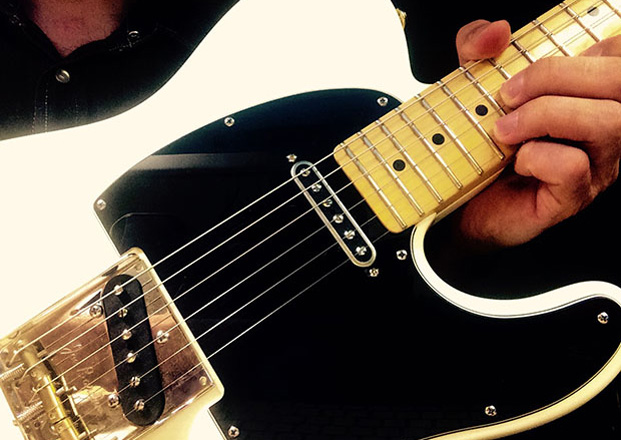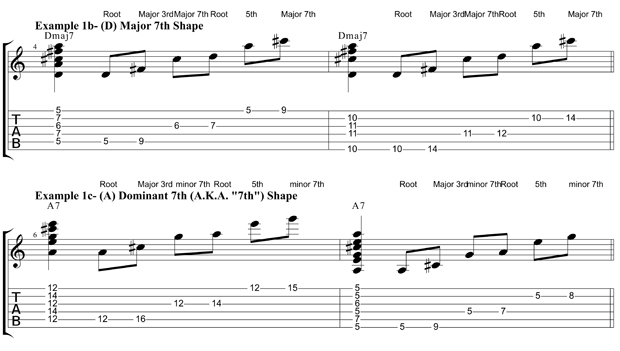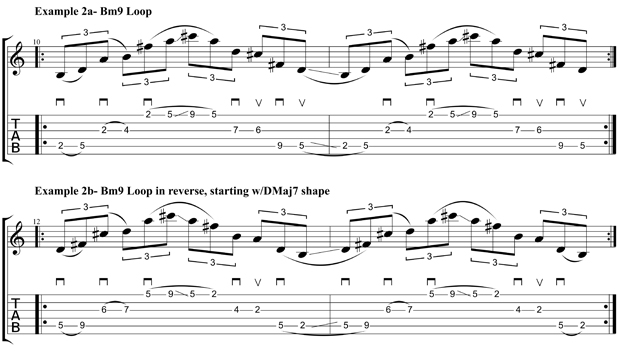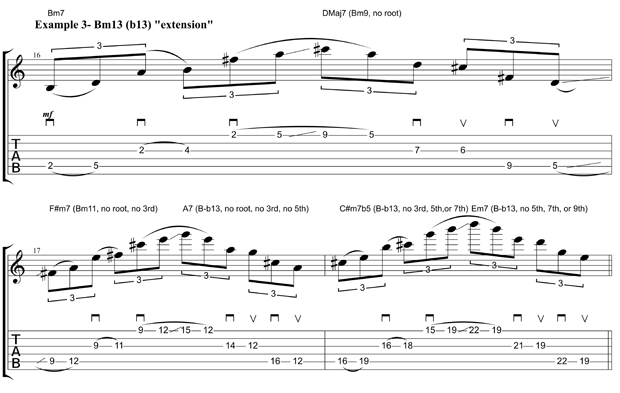Slippery, Sliding, Open-Voiced, String-Skipping 7th Arpeggios
This deceptively easy-to-play, simple concept will add some sophistication to your improvisations.

This time around, I’d like to share a trick based around a deceptively easy-to-play, simple concept that will add some sophistication to your improvisations (while also being sure to turn heads with its attention-grabbing coolness!): open-voiced, string-skipping 7th arpeggios.
The basic idea is this: Instead of playing 7th chord arpeggios sequentially in a root-3rd-5th-7th manner, we’ll split up the arpeggios into six-note patterns with two notes per string on three strings, skipping a string in between each.
The resulting intervallic shift of these patterns “opens up” the voicing of the chords and creates an ear-catching sound that gives the illusion of being somewhat “outside” while still remaining completely within the confines of the key. Plus, with savvy use of these arpeggios and a rudimentary understanding of music theory, these shapes can be a shortcut to extreme harmonic depth.
Just to get us all on the same page (and to satisfy my fellow theory nerds out there), please be reminded of the following rules of 7th chords:
- 1) 7 means b7 (flat 7)
- 2) “Minor,” “min” or “-" only refers to the b3
- 3) “Major” or “Maj” in a 7th chord (or higher) only refers to the “natural” (A.K.A. “major”) 7th
- 4) The 5th of the chord is “natural” or “perfect” unless otherwise noted (“+” for #5 or “b” for flat 5)
So, defining the basic (and a few more) 7th chords:
• 7, "dominant 7" = 1, 3, 5, b7
• -, "minor 7", m7, min7 or -7 = 1, b3, 5, b7
• M7, "major 7" or the delta symbol = 1,3,5,7
• half diminished = m7 (b5) = 1,b3, b5, b7
• dim = "diminished 7"= 1, b3, b5, bb7 (this chord with a major 3 would be a "6(b5)”)
• m7M, “minor Major 7," -M7,-7M (abbreviations vary) = 1, b3, 5, 7
• m7M(b5)= 1, b3, b5, 7
• 7(b5)= 1, 3, b5, b7
• M7(b5)= 1, 3, b5, 7
Remember the rule: "7" means "1, Major 3rd, 5th and FLAT 7."
Now that that’s out of the way, let’s get to the really fun stuff. All of the examples are in the key of Bm (B, C#, D, E, F#, G, A). The 7th chords in key are Bm7, C#m7(b5), DMaj7, Em7, F#m7, GMaj7, A7.
Example 1a is the basic minor 7th shape/pattern (I’ve also included the standard chord shapes so you can see how the arpeggio relates). Using the two notes-per-every-other-string concept, the voicing of the arpeggio is Root, minor 3rd, minor 7th, Root, 5th, minor 7th. Notice how the shape is comfortably reminiscent of a minor pentatonic scale.

Since any given natural major or minor key has four types of 7th chords (major, minor, dominant and minor 7 flat 5th), examples 1b through 1d illustrate the other three shapes in the key of Bm (to play the other chords in the key, simply move the shapes relative to the other root notes).


Technique-wise, try linking together adjacent shapes as in Examples 2a and 2b. The hip thing about linking together the two shapes is that by adding the DMaj7 (D,F#,A,C#) pattern to the Bm7 (B,D,F#,A) pattern over a Bm harmony, you can imply a Bm9 (B,D,F#,A,C#)!

Hmmmm … What if we kept going? Example 3 continues the link with the “pinky note of the first arpeggio becomes the root note of the next arpeggio” idea and ramps up the harmonic complexity to a full Bm13 (flat 13) chord (B,D,F#,A,C#,E,G - every note in key but spread out in patterns like fractal art)! Note the explanations of the theory in the notation, and try this with the other chords in key (also check out the pattern in the missing notes in the extensions for further fun). Experiment with the directions in which you play the arpeggios and with where you start the “extensions” relative to the underlying harmony.

Example 4 is a melodic/thematic idea that should get you started with messing around with combining and moving around these shapes.

And just in case that hasn’t given you enough to work on, Example 5 takes a different turn on the concept and shows a sequenced shred pattern of the C#m7(b5) shape. Try this sequence with the other arpeggios in key and see if you can’t find a way to fit it in as a head-turner in a solo!

Move these arpeggios to your favorite keys and use the theory ideas to inject some mental and physical Guitar Strength into your improvs and compositions that’s guaranteed to get some love from your listeners when used creatively. Happy shredding!
P.S.: Food for thought on a completely unrelated note: If you haven’t focused on it seriously for a while, work on your vibrato!
Scott Marano has dedicated his life to the study of the guitar, honing his chops at the Berklee College of Music under the tutelage of Jon Finn and Joe Stump and working as an accomplished guitarist, performer, songwriter and in-demand instructor. In 2007, Scott developed the Guitar Strength program to inspire and provide accelerated education to guitarists of all ages and in all styles through state-of-the-art private guitar lessons in his home state of Rhode Island and globally via Skype. Visit Scott and learn more at www.GuitarStrength.com.
Get The Pick Newsletter
All the latest guitar news, interviews, lessons, reviews, deals and more, direct to your inbox!
Scott Marano has dedicated his life to the study of the guitar, honing his chops at the Berklee College of Music under the tutelage of Jon Finn and Joe Stump and working as an accomplished guitarist, performer, songwriter and in-demand instructor. In 2007, Scott developed the Guitar Strength program to inspire and provide accelerated education to guitarists of all ages and in all styles through state-of-the-art private guitar lessons in his home state of Rhode Island and globally via Skype.
“There are so many sounds to be discovered when you get away from using a pick”: Jared James Nichols shows you how to add “snap, crackle and pop” to your playing with banjo rolls and string snaps
Don't let chord inversions bamboozle you. It's simply the case of shuffling the notes around







![Joe Bonamassa [left] wears a deep blue suit and polka-dotted shirt and plays his green refin Strat; the late Irish blues legend Rory Gallagher [right] screams and inflicts some punishment on his heavily worn number one Stratocaster.](https://cdn.mos.cms.futurecdn.net/cw28h7UBcTVfTLs7p7eiLe.jpg)


